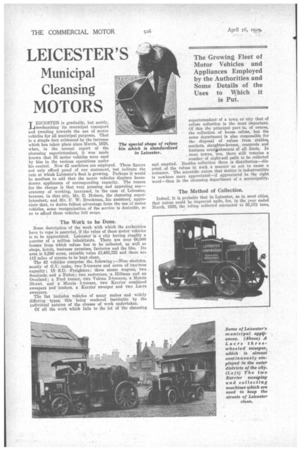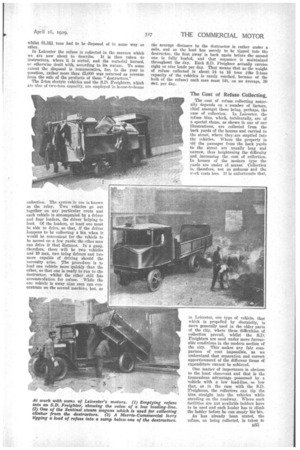LEICESTER'S
Page 120

Page 121

Page 122

If you've noticed an error in this article please click here to report it so we can fix it.
Municipal Cleansing
MOTORS
LEICESTER is gradually, but surely, mechanizing its municipal transport and trending towards the use of motor vehicles for all municipal purposes. That is a simple fact evidenced by the increase which has taken place since March 1928, when, in the annual report Of the cleansing superintendent, it was made known that 35 motor vehicles were used by him in the various operations under his control. Now 42 machines are employed. These figures not only afford proof of our statement, but indicate the rate at which Leicester's fleet is growing. Perhaps it would be needless to add that the motor vehicles displace horsedrawn appliances of corresponding capacity. The reason for the change is that very pressing and appealing one— economy of working, increased, in the case of Leicester, because, in that city, Mr. E. Hobson, the cleansing superintendent, and Mr. P. W. Brookman' his assistant, appreciate that, to derive fullest advantage from the use of motor vehicles, some reorganization of the service is desirable, so as to afford those vehicles full scope.
The Work to be Done.
Some description of the work with which the authorities have to cope is essential, if the value of these motor vehicles is to be appreciated. Leicester is a city having roughly a quarter of a million inhabitants. There are over 60,000 houses from which refuse has to be collected, as well as shops, hotels, business premises, factories and the like. Its area is 8,586 acres, rateable value £1,483,325 and there are 112 miles of streets to be kept clean.
The 42 vehicles comprise the following electries, mostly of G.V. make, two 5-tonners and seven of two-tons capacity ; 18 S.D. Freighters; three steam wagons, two Sentiaels and a Foden; two motorcars, -a Hillman -and an Overland ; a Ford tanner,two Vulcan 2-tonners, a Merris 30-cwt, and a Morris 1-tonner, two Karrier combined sweepers and loaders, a Karrier sweeper and two Lacre sweepers.
The list includes vehicles of many makes and widely differing types, this being rendered inevitable by the individual natures of the classes of work undertaken.
Of all the work which falls to the lot of the cleansing superintendent of a town or city that of refuse collection is the most important. Of this the principal part is, of course, the collection of house refuse, but the same department is also responsible for the disposal of refuse from stables. markets, slaughter-houses, cesspools and business estaliiishments of all kinds. In . most towns, 'too, there still remains a number of night-soil pails to be collected and emptied. Besides collection there is distribution—disposal of the refuse in such a manner as not to cause a nuisance. The scientific axiom that matter is indestructible is nowhere more appreciated—if appreciated be the right word—than in the cleansing department of a municipality.
The Method of Collection.
Indeed, it is probable that in Leicester, as in most cities, that axiom could be improved upon, for, in the year ended March, 1928, the refuse collected amounted to 55,572 tons,
whilst 61,101 tons had to be disposed of in sonic way or other.
In Leicester the refuse is collected in the manner which we are now about to describe. It is then taken to destructors, where it is sorted, and the material burned, or otherwise dealt with, according to its nature. To some extent the disposal is remunerative, for, in the year in question, rather more than £5,000 was returned as revenue from the sale of the products of these "destructors."
The 2-ton electric vehicles and the S.D. Freighters, which are also of two-tons capacity, are employed in house-to-house
collection. The system in use is known as the relay. Two vehicles go out together on any particular route and each vehicle is accompanied by a driver and four loaders, the driver helping to load. Of the loaders, at least one must be able to drive, so that, if the driver happens to be collecting a bin when it would be convenient for the vehicle to be moved on a few yards, the ether man can drive it that -istance. In a gang, therefore, there will be two vehicles and 10 men, two being drivers and two more capable of driving should the necessity arise. The procedure is to load one vehicle more quickly than the other, so that one is ready to run to the destructor, whilst the other still has accommodation for refuse. While the one vehicle is away nine men can concentrate on the second machine, but, as
the average distance to the destructor is rather under a mile, and as the load has merely to be tipped into the destructor, the first away is back again before the second one is fully loaded, and that sequence is maintained throughout the day. Each S.D. Freighter actually carries eight or nine loads per day. That means that as the weight of refuse collected is about 14 to 18 tons (the 2-tons capacity of the vehicles is rarely reached, because of the bulk of the refuse) each man must lift, on an average, 30 Cwt. per day.
The Cost of Refuse Collecting.
The cost of ref use collecting naturally depends on a number of factors, chief amongst these being, perhaps, the ease of collection. In Leicester, the refuse bins, which, incidentally, are of a special shape, as shown in one of our illustrations, are collected from the back yards of the houses and carried to the street, where they: are emptied into the vehicles. Where the property is old the passages from the back yards to the street are usually long and narrow, thus heightening the difficulty and increasing the cost of collection. In houses of the modern type the yards are easier of access. Collection is, therefore, not so arduous and the work costs less. It is unfortunate that, in Leicester, one type of vehicle, that which is propelled by electricity, is more generally used in the older parts of the city, where these difficulties of collection prevail, whilst the S.D. Freighters are used under more favourable conditions in the modern section of the city. This makes any fair comparison of cost impossible, as we understand that separation and correct apportionment of the different items of expenditure cannot be achieved.
One matter of importance is obvious to the least observant and that is the tremendous advantage possessed by a vehicle with a low load-line, so low that, as in the case with the S.D. Freighters, the collectors can tip the bins, straight into the vehicles while standing on the roadway. Where such facilities are not available ladders have to be used and each loader has to climb the ladder before he can empty his bin.
As has already been stated, the refuse, on being collected, is taken to one of four destructors, each of which has a capacity of up to 800 tons per week, and is tipped straight into what is best described as a sump, below the main building of the destructor. There it is collected by huge mechanical grabs, elevated into the destructor itself, where the material is sorted, some of it being burned and the rest, such as tin cans, which are compressed into slabs of scrap metal, dealt with according to the material and the use to which it may be put. In the list of sources of revenue derived from these destructors the following items appear :—Sale of ashes and mortar, tins, slabs for building and supply of steam and electric light.
A good deal of refuse is, of course, incinerated, and the outcome of this is a considerable quantity of clinker. This is taken to appropriate dumps, for which purpose steam wagons have been found to be most suitable.
Street Cleansing.
Next in importance to refuse collection comes street cleansing, the two being, of course, closely related. The streets are swept partly by motor vehicles and partly by
hand labour. Five motor vehicles are employed, two of which are sweepers and collectors, these being of Kessler manufacture, as also is one of the other three sweepers, the remaining two being Lacres. As an indication of the amount of work that can be completed with a motor Vehicle—operations which would require a considerable amount of hand labour and a large number of collecting vehicles—one of them sweeps and collects five loads in a night, travelling a distance of 30 miles. The street sweepings left by the other machines and by the manual labourers are collected by horsed vehicles and the Morris 30-cwt. vehicle.
General-purpose Machines.
The G.V. electric 5-tonners are what may be termed general-purpose machines, as they are used for the collection of street refuse, house refuse or waste material from factories and similar establishments, or, alternatively, with interchangeable tank bodies, for street watering.
All the machines are housed at a central depot, in Jarvis Street, where provision is made for repairs and overhauls, also for the charging of the batteries of the electric vehicles.








































































































































































































